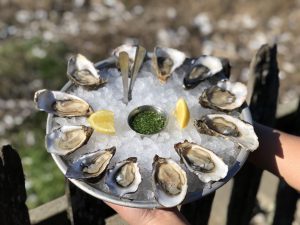
Oysters: Beneficial Bivalves
Summary
The Mighty Oyster
In many ways, oysters are the unsung heroes of the ocean. They are nutritional powerhouses, packed with protein, omega-3 fatty acids, zinc, and vitamin B12. In addition to their myriad health benefits, oysters play an essential role in ocean environments. They are filter feeders, which means that they feed by pumping large amounts of water through their bodies and trapping food particles like phytoplankton and algae. Through this filtering process, oysters remove nitrogen and phosphorus from the water, and prevent algal bloom. One oyster can filter up to 50 gallons of ocean water a day, and this is no small contribution. By filtering and cleaning the water, oysters make it more habitable for other organisms like underwater grasses.
Hog Island Oyster Co.
In Marin, we are fortunate to have an exceptional oyster producer in our own backyard. Hog Island Oyster Co. has been growing oysters in Tomales Bay, CA since 1983. Their approach to growing oysters is much like their approach to building their business. They believe that “good things grow slowly”, and for this reason, they have taken great time and care to develop sustainable aquaculture techniques, while cultivating a community of like-minded people to help them better understand and share the impacts of changing ocean conditions.
The Hog Island team grows several varieties of oysters including: Sweetwaters, Atlantics, Kumamotos, French Hog, Earthquake Bays, and Olympias. They use a ‘rack and bag’ growing system adapted from French aquaculture. As part of this system, oysters are planted by the hundreds in reusable mesh bags fastened to rebar racks which elevate the oysters from the bay floor. Being elevated from the bay floor allows the best tidal flow to surround the shellfish so they can easily feast on the phytoplankton and nutrients in the water. Depending on the species of oyster, they will spend anywhere from 12 months to three years here, filtering gallons of seawater every day, as they feed. Hog Island does not put any feed or fertilizers in the water, andfarming their oysters is still a very hands on process. Their crew is out in the bay on a regular basis, flipping, shaking and tipping the bags of oysters to improve their shape and overall quality.
Hog Island is a certified B Corp, and a founding member of the Shellfish Growers Climate Coalition, an environmental advocacy organization that seeks to promote sound climate policy to benefit ocean habitats. In 2012, they began a partnership with Dr. Tessa Hill of the UC Davis Coastal and Marine Sciences Institute to monitor ocean acidification in Tomales Bay, and its impact on their shellfish.
They are also collaborating with The Nature Conservancy and the University of California Santa Cruz to study the relationship between oyster aquaculture and the health of eelgrass beds. Eelgrass is an important ocean plant that provides foraging areas for fish, food for turtles, and spawning surfaces for a number of underwater species. In California, 90% of eelgrass acreage has been lost since the 1850s. The team at Hog Island has noticed an expansion in eelgrass growth around their oysters over the years, and their hope is to better understand this environmental interaction, and how their practices might be encouraging this growth.
We applaud the work that Hog Island Oyster Co. is doing to perfect their product and their practices. Look for their offerings in our Seafood case.

Further Reading

Local Body Care: Our Top Picks
Read More trending_flat
Wild West Ferments
Read More trending_flat